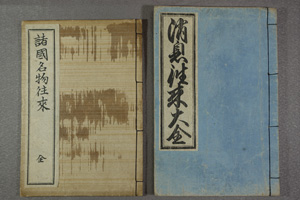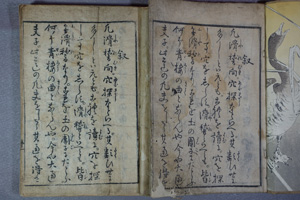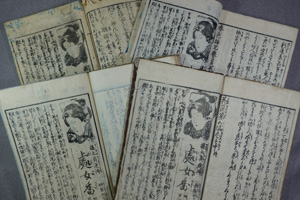Classical Japanese Books with Potential
Ryusei Matsunaga
Graduate School of Letters of Chuo University and Research Fellow (DC1) of the Japan Society for the Promotion of Science
Area of Specialization: Japanese literature in early modern period
Introduction
I was fortunately selected as a research fellow (DC1) of the Japan Society for the Promotion of Science for fiscal 2018, mainly thanks to the support from people around me and the encounter with classical Japanese books.
Here, I would like to reflect on my experiences, hoping that future applicants for research fellow would read my article.
Collecting odd volumes to start my research

Figure 1

Figure 2: Books produced with different printing blocks (Keiseikai-toranomaki)

Figure 3: Ninjobon books including the ads of musumeko
The first classical Japanese books I purchased are “Shokoku-meibutsu-ourai” (published in 1824) and “Shousoku-ourai-taizen” (published in 1845) authored by Namisuke Hosokawa (Figure 1). I purchased them at 1,000 yen each when I was a sophomore in an undergraduate department. Since then, I have been collecting classical Japanese books while frequently checking used book shops, classical book fairs and online auctions.
Initially, I enjoyed collecting books priced at around 1,000 to 2,000 yen, but since I determined the theme of my graduation thesis, I focused on collecting books in the genre called gesaku (light literature). Gesaku collectively means entertainment books in the Edo Period, including yomihon (fictions), sharebon (gay-quarter novelette), kokkeibon (comic novels), ninjobon (love stories) and kusazoshi (story books with illustrations). Especially, I started collecting sharebon and ninjobon, which were closely related to my graduation thesis. Since sharebon books were very expensive, I had no choice but to collect ninjobon books, especially low-priced incomplete sets of books.
As I accumulated books, I often bought the same volume of the same series. Comparing them, I found that books vary in size, front cover, printing quality, etc. even for the same volume, and there are no identical books. I also found that different printing blocks had been used for the same book. (Figure 2) Through the comparison of these classical Japanese books, I realized their attractiveness and profoundness as well as inherent difficulty. This can only be recognized as the fruit of collection of incomplete sets of books.
While adding new books to my collection, I noticed that the same kind of ads had been posted in ninjobon books (Figure 3). These ads introduced musumeko with the tagline “Tamenagashunsui-seizai” and the distributor was “Oshimaya Denemon, Bun’eido, a publisher of books and picture books.” I was attracted by the fact that the ads had been posted in not only books printed with relatively fresh blocks, but also books printed with old blocks and the existence of Oshimaya introduced as a publisher of books and picture books. While delving into them, I started focusing on Oshimaya, and then chose it as my research theme when applying for becoming a research fellow of the Japan Society for the Promotion of Science.
Oshimaya Denemon, a wholesaler of rental books
I am researching the distribution process of gesaku books, from the publication to delivery to readers. As a research method, I focus on Oshimaya.
As for the delivery to readers, entertainment books, including gesaku, had been read mostly through rental until the early modern period. Books had been expensive, and people’s motivation to collect entertainment books had been weak. Therefore, I cannot ignore the existence of rental book shops, when discussing gesaku.
Publishers of gesaku books, too, operated businesses while putting importance on rental book shops, which were their business partners. Especially, wholesalers of rental books specialized in the marketing targeted at rental book shops. Oshimaya continued business as a wholesaler of rental books handling mainly kokkeibon and ninjobon from the late part of the early modern period to the beginning of the late modern period. Oshimaya was not only related closely to gesaku and rental book shops, but also could provide me with a viewpoint for studying the times.
In my research, I first focused on the old stocks and stock seals of rental book shops, in order to visualize the distribution of kokkeibon and ninjobon books in which Oshimaya involved. Some seals included not only the name of a rental book shop, but also its address. By garnering such information, I tried to elucidate the book distribution network centered around Oshimaya. Through this effort, I was able to clarify part of the distribution network and people’s willingness to enjoy gesaku through rental book shops. (Matsunaga: Popularity of "Chubon" Books and Oshimaya-Denemon — the Publisher and wholesaler of rental books)
Oshimaya still continues to be my main focus of research. In addition, I hope to investigate other wholesalers of rental books and industries which had a relation with book rental. Through these efforts, I would like to provide more detailed history in publication, distribution and popularity surrounding gesaku.
Conclusion
It is no exaggeration to say that I would not have encountered with Oshimaya, come up with an idea about my research theme, applied for becoming a research fellow of the Japan Society for the Promotion of Science and been employed if I had not made a habit of collecting classical Japanese books. That was a product of chance gained exactly because I was searching for and collecting a broad range of classical Japanese books.
I rarely see a person of my generation looking for classical Japanese books at used book shops and classical book fairs throughout the nation. I think that this truly reflects the scarcity of young scholars in this field. Humanities, including literature, may be destined for dwindling. In this situation, I think that more young scholars need to flourish and revitalize this field.
No matter whether I will be able to flourish, I have to struggle, as I am still young. I will search for classical Japanese books in the hope of becoming a leading researcher in this field.
- Ryusei Matsunaga
Graduate School of Letters of Chuo University and Research Fellow (DC1) of the Japan Society for the Promotion of Science
Area of Specialization: Japanese literature in early modern period -
Ryusei Matsunaga was born in 1994. He graduated from the Department of Japanese Literature in the Faculty of Letters, Kokugakuin University in 2016. He completed the Master’s Program in the Japanese Literature course in the Graduate School of Letters, Chuo University in 2018. Currently, he is enrolled in the Doctoral Program of the same course. He has a position as a research fellow (DC1) of the Japan Society for the Promotion of Science.
He authored the following papers: Popularity of "Chubon" Books and Oshimaya-Denemon — the Publisher and wholesaler of rental books (Kinsei Bungei Vol. 109, Nihon Kinseibungakukai, January 2019), Chronology of publications by Oshimaya Denemon (Shomotsu Shuppan-to-Shakaihenyou Vol. 21, Society for Researching Books, Publication and Social Changes, October 2018) and One Aspect of Ikedaya Seikichi of Seikoudo—Business Operation and Daily Life of a Rental Book Shop in the Meiji Period as Seen from the Viewpoint of Documents (Chuo Daigaku Kokubun Vol. 60, Japanese Literature Society of Chuo University, March 2017).
- Research Activities as a Member of Research Fellowship for Young Scientists (DC1), Japan Society for the Promotion of Science (JSPS) Shuma Tsurumi
- Important Factors for Innovation in Payment Services Nobuhiko Sugiura
- Beyond the Concepts of Fellow Citizens and Foreigners— To Achieve SDGs Goal 10 “Reduce Inequality Within and Among Countries” Rika Lee
- Diary of Struggles in Cambodia Fumie Fukuoka
- How Can We Measure Learning Ability?
—Analysis of a Competency Self-Assessment Questionnaire— Yu Saito / Yoko Neha - The Making of the Movie Kirakira Megane

-
Newest Edition 2019 Autumn Issue
Student journalists report on the students’ take of Chuo University

-
Chuo-DNA
The school's history and motto have been passed on to graduates and students alike. Here is a visualization of Chuo University in the future.Core Energy
Launching Chuo University's Knowledge into Action to the rest of the world, like an infinity of sparkling stars scattered throughout space.
Planned by The Yomiuri Shimbun Business Bureau [PR]















